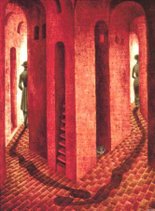The passive is expressed in two ways in Norwegian. First of all, by the auxiliary å bli ("become, get") with the past participle of the main verb: å bli rost = to be praised.
For "he was caught" English can also say "he got caught" and then comes very near the Norwegian construction.
But Norwegian, like other Scandinavian languages, has passive forms ending in -s: han roses = he is praised.
This -s is actually a remnant of the Old Norse reflexive sik (seg in modern Norwegian), which in course of time was reduced to -s when tacked on to the verb.
In most cases, the s-form can be changed into expressions with bli: han kastes ("he is thrown") into han blir kastet.
Sometimes, however, there is a slight nuance between the two forms.
The s-form has a more general meaning and is often used about customary and repeated actions. They are often met with in public notices and in announcements and advertisements. Constructions with bli are often used to denote isoleted and limited actions.
But on the whole, s-forms have a rather restricted use. they are quite common in the present tense and in the passive infinitive after the so-called modal auxiliaries.
In the past tense, it is rare, let alone the perfect tenses, but when it comes to verbs of the first conjugation (the -et class) we get such clumsy forms as kastedes, which belong to a bygone period. You may found them in the works by Ibsen, Bjørnson, Lie and Kielland.
The s-form is hardly ever used in the past tense of strong verbs either.
You can find a few examples and a quiz about this topic here.
Friday, February 15, 2008
Subscribe to:
Post Comments (Atom)











No comments:
Post a Comment